Laminate underfloor heating: installation and installation of a film infrared system
By installing a warm floor under the laminate as the only or additional way of heating the room, you can significantly increase the degree of comfort compared to other options. To draw up a layout of the elements and complete the installation of the entire system, you need to familiarize yourself with the specifics of the work. Do you agree?
We will tell you how to choose a floor covering that can work in tandem with a heating film system. Here you will learn how to correctly position the components of the warm floor and how to connect them correctly. Based on our advice, you will be able to independently carry out all the stages of a difficult, but quite affordable job.
The content of the article:
Material Guidelines
The quality of work and the life of the underfloor heating laid under the laminated panels depends on the parameters of the purchased equipment and material, together with an understanding of the features of their combination.
For self-development of the layout of infrared bands, it is necessary to take into account the physical features of such heating.
Parameters of infrared film floor
The film heater is a flexible narrow cloth placed under the floor covering and containing a heating element. It converts electrical energy into infrared heat waves.
Laminate or other material is heated from below due to radiation falling on it. After heating the floor surface in thickness, heat is transferred to the air of the heated room.
As a heating element of IR systems, carbon solid or strip spraying is used, closed on both sides with a lavsan or polyurethane film. Current-carrying bimetallic tires are installed along the edges of the canvases, which transmit energy to the heating element.
The thickness of this design varies from 0.2 to 2 mm, most often on sale there are panels with a thickness of 0.3 to 0.5 mm. The standard widths of one strip are 50, 60, 80 and 100 cm.
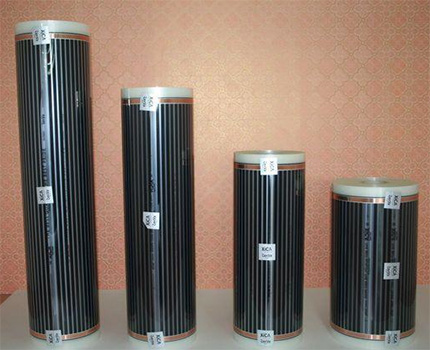
Any film can be cut lengthwise in specially designed and marked places for this. The size of the step of the cut is approximately equal to 20 cm, so without difficulty you can get the panels of the desired length.
Maximum power infrared film under the laminate is from 120 to 230 W / sq.m. Devices with large heat dissipation are not used due to the limitation of the heating temperature of the laminate. Sometimes, the manufacturer indicates the power depending on the running meter. In this case, dividing it by the bandwidth, you can calculate the desired value.
Laminate requirements as a coating
An ordinary laminate can have three properties that prevent its use as a topcoat complete with a warm floor:
- distortion of the geometry of the plates under the action of high temperature;
- punching plates when exposed to heavy objects;
- high thermal insulation properties of the material.
Therefore, for the joint use of the laminate and the film underfloor heating underneath, advanced models are developed. They are marked with special characters placed on the packaging of the material or in the instructions for it.
There is no single labeling standard, therefore, when buying, you need to clarify this question with the seller, since there are solutions only for water or electric cable underfloor heating.
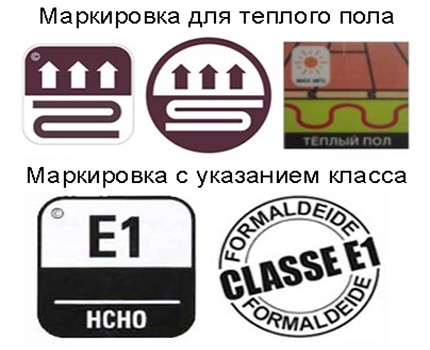
The total value of the coefficient of thermal resistance of the laminate and the substrate on which it is laid should not exceed 0.15 square meters * K / W. Therefore, when choosing a material, you must make sure that this technical characteristic meets the regulatory requirements, otherwise there is a risk of overheating and damage to the underfloor heating system.
The lamellae can be connected with glue or locks located on the ends of the plates. Together with a warm floor, only a floating scheme of the device of a laminated floor from castle-type panels is allowed.
Those. the coating assembled from the panels should not have rigid adhesion to the base, and along the perimeter of the room, around architectural details and pipe penetrations, it is necessary to leave a gap as a reserve for linear expansion of the material.
Laminate is obtained by pressing sawdust with the inclusion of resins containing formaldehyde.The manufacturer indicates the maximum permissible heating temperature, above which the evaporation of the toxic substance begins. This usually happens when you reach 28-30 degrees Celsius. When calculating heat generation, this factor must be taken into account.
The arguments in favor of installing an infrared heating system for a laminate and a comparison of the advantages of an IR film with water options are detailed in the next articlewhich we recommend that you familiarize yourself with.
Rules for placing strips of underfloor heating
The area of a separate room, which should be equipped with a warm floor, is calculated based on the heating needs of this room.
In the absence of other heating systems, an average of 70% of the total area coverage is sufficient. In the presence of radiators, fireplaces, the need for heat from the floor is reduced, which leads to a decrease in the number of stacked strips or less energy consumption for heating.
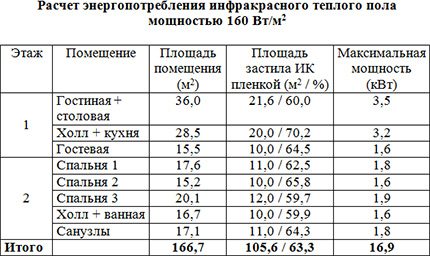
The absence of the need to place an infrared warm floor under the laminate over the entire area of the room allows, as a rule, when designing, it is easy to circumvent the following restrictions:
- Do not place underfloor heating under heavy objects such as cabinets or legged sofas. They push through the laminate, which leads to an uneven fit and excessive pressure on the film.
- Do not cover the heated laminate with heat-insulating material, such as carpets or furniture without legs. This leads to a violation of the heat transfer to the air and overheating of the system.
- It is necessary to avoid heating the laminate simultaneously from the side of the infrared film and another heat source. The size of the floor area, under which it is impossible to lay a film for each type of adjacent heating device, is determined individually.
- It is necessary to deviate from walls and stationary objects at least 3 - 10 cm, depending on the manufacturer's recommendations, since the heating zone in the plan slightly extends beyond the boundaries of the film. Elevated temperatures can have a bad effect on skirting boards and wallpapers.
When planning the placement of an infrared film, they often recede from the walls by a distance of 50-60 cm. This is due to a possible redevelopment or rearrangement of furniture in the future.
A significant indent from the walls leaves a wider range of solutions for changing the design of the room. In addition, residents of the house are much less likely to use the space near the wall than in the middle of the room.
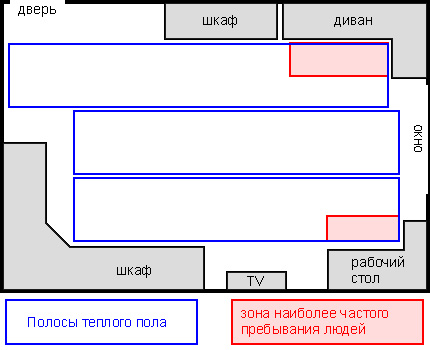
If the area of the heated floor is rectangular, then the location of the film fragments is best planned along the long side. In this case, the number of strips is reduced and, as a result, the operations of their laying, insulation and connection.
Additional structure information
In a vertical section, the underfloor heating device consists of five layers, each of which has certain requirements. The base of the floor should be firm and as even as possible. For a concrete base, it is recommended to level it by pouring a leveling mixture, and for a wooden one, by laying plywood.
The insulation between the base and the heating elements is designed to prevent heat loss. Given that the warm floor is powered by electricity, the substrate should not conduct current.
Therefore, do not use insulation with a reflective surface based on aluminum foil. Most often, rolled polyethylene foam insulation or cork substrate complete with a reflective layer is used.
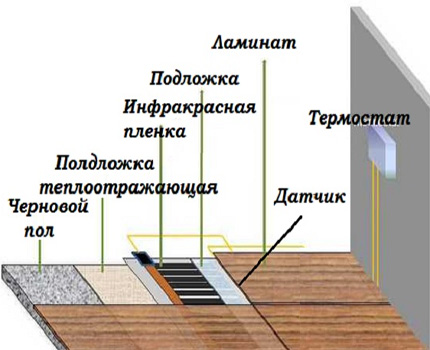
Before laying strips of underfloor heating with electrical wiring and a temperature sensor, you must read the instructions that came with the kit. The general principles of installation are the same, but there are some nuances in terms of the distance between the placed elements, as well as in the method of connecting to the mains.
As a substrate located between the heating elements and the laminate, you need to use a plastic or vinyl film. It passes heat well, but serves as a barrier to water and dust, which cannot be allowed to enter the heating strips.
One of the characteristic representatives of film heating systems is products of the brand PLEN, the features of the installation and operation of which are described in detail in our recommended article.
System installation steps
One of the major advantages of infrared bands over electric cable or water pipes is the ability to independently install a warm floor under the laminate. Therefore, installing such a system is cheaper, which justifies the more expensive cost of its elements.
With the correct implementation of all stages of the work, the heating will function qualitatively as declared by the manufacturer for a period of time.
Leveling the base and laying thermal insulation
Waterproofing and leveling the base of the floor for the subsequent laying of infrared strips under the laminate is performed according to standard rules. The coating should be smooth, hard, with a slope of not more than 2 mm per 1 meter.
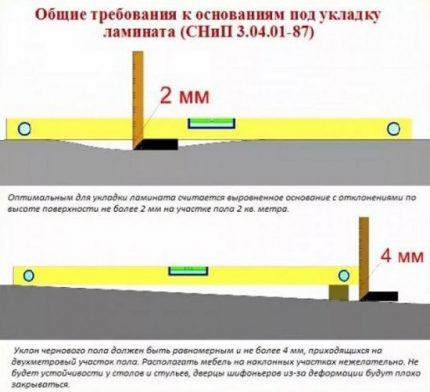
Before installing thermal insulation, dust must be removed from the room. If work on the organization of the warm floor is carried out during the period of construction or overhaul, it is advisable to follow the procedures for the installation of thermal insulation, heating strips and upper waterproofing in one go. In this case, dust pollution of the heating elements will be minimized.
Heat-reflecting material is inexpensive, so it is laid over the entire area of the room close to the walls, even if infrared stripes are not located under the entire floor surface. The thickness of the insulating substrate under the underfloor heating is 3-4 mm and this arrangement eliminates a slight difference in height, undesirable when installing the laminate.
To avoid material shear during further work, it is attached to the floor with a stapler or double-sided tape. Between themselves, the strip of the isolon or other insulation is fixed with tape.
Photo-guide for building an IR system
In laying a warm film floor, a number of standard actions are performed, represented by the following selection of photos:
Having completed the preparation of infrared strips for the assembly of a warm floor, we proceed to the main work:
Placement of thermal film fragments
Thermofilm strips are cut into fragments of the desired size and stacked with a copper strip up or down, depending on the manufacturer's instructions. It is necessary to arrange them in such a way as to carry out the wiring of the electric cable from only one side.
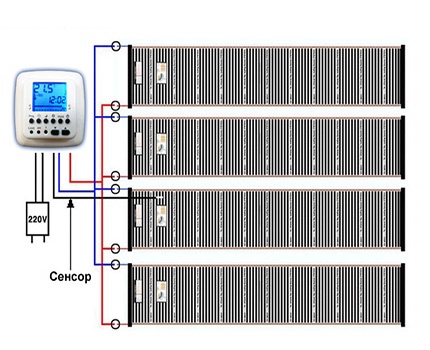
As a rule, laying under the laminate of the heating strips of the heated floor is performed end-to-end. However, for some models there is a minimum permissible distance between them, which is indicated in the instructions. It must be observed to avoid overheating of the system. In no case should it be unlawful to overlap strips of current-carrying tires on top of each other.
Increasing the distance between the strips above the minimum allowed will not cause malfunctioning of the warm floor. In this case, the heating of the laminate will be uneven, which will lead to the creation of warm and cold zones on the floor. However, such zones are practically not noticeable due to a small temperature difference and the existence of the effect of heat dissipation.
Insulation and connection to electricity
Usually, in addition to thermal film, a self-adhesive insulating bitumen (butyl rubber) tape and contact clips for connecting the floor to the mains are included in the package. Sometimes the kit also includes wires with the cross-section necessary to pass a current of a given power.
Self-adhesive bitumen insulation covers those sections of the copper-silver busbar cut and on the opposite side of the strip of its “open” contacts that will not be used when connected to the power grid. It is important to prevent air bubbles from forming between the insulation and the busbar.

A contact clip is installed in each place where the wires are connected to the copper bus so that one of its sides goes inside the thermal film, and the second remains outside, on top of the copper strip. Then, using pliers, tighten the clips.
After this procedure, the strip of thermal film is fixed with adhesive tape between each other, and also connected with heat-reflecting material in order to avoid shear during subsequent work.
The stripped ends of the wires are connected to the clips by crimping. Each such place must be covered with bitumen insulation, laying it on top and bottom of the connection.
Connecting a thermostat and system testing
The control device is rarely supplied, therefore thermostat for underfloor heating need to be purchased separately. Since high accuracy is required to adjust the temperature of heating the laminate, it is necessary to use an electronic device, not a mechanical type.
The floor temperature sensor is attached from the bottom of the film to the black strip of the heating element. This procedure can be performed using bitumen insulation.
In the heat-reflecting material, special cuts are made for the temperature sensor, as well as the installation location of the clips and wiring. This is necessary to maintain the smoothness of the surface for the installation of the laminate. Having placed the sensor in the recess, it must be sealed with bitumen insulating tape.
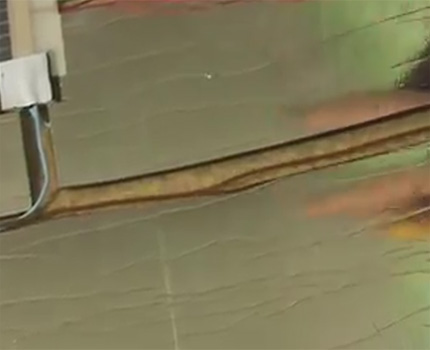
The temperature controller is mounted on the wall in the place most convenient for the residents of the apartment. The wires are connected according to the instructions for the device.
If the maximum power of the underfloor heating exceeds 2 kW, then the connection to the mains is done through a separate machine. For humid rooms, such as a bathtub or a bathroom, in the absence of grounding, a residual current device must be included in the electrical circuit.
Before laying the waterproofing layer and the laminate, it is necessary to test the system. The test temperature may be small, since the main goal is to check the connections of the wires with the elements of the infrared floor for sparking, as well as the fact of heating of each fragment.
Waterproofing and laminate flooring
On top of the warm floor, a protective waterproofing coating is laid in the form of a film. Given its insignificant thickness, which does not affect the surface topography, it is enough to close only the heating elements with a small protrusion at the edges, equal to 10-20 cm.
The film strips are interconnected using ordinary tape to avoid their shift during subsequent installation of the laminate.

Laminate floor panels are laid immediately on top of a plastic film, without any additional backing. It is advisable to carry out these procedures in soft shoes, as well as observe other safety measures so as not to damage the waterproofing and heating elements.
The nuances of operating the infrared floor
It is necessary to sketch a plan of the device of the warm floor under the laminate, including the layout of the strips and wiring. This will help prevent future improper relocation of furniture and the creation of strong pressure on the surface in places of installation of underfloor heating.
You will also need to exclude the possibility of damage to the film or electrical wiring when installing interior items that require end-to-end fastening to the subfloor.
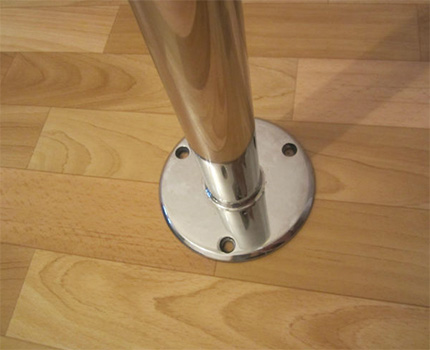
Electronic temperature controllers are often equipped with two instruments for measuring the temperature of the floor and air. When using the system programming only the air sensor cannot be used due to restrictions on laminate heating.
There are two ways to correctly set the algorithm of the floor heating mode:
- Use only floor sensor readings. For example, set the heating to turn on at a temperature below 25 degrees, and turn off when it reaches 29 degrees.
- Use the readings of both instruments. For example, set the heating to turn on at a room temperature of 23 degrees, and turn it off when either the air sensor reads 26 degrees or the floor sensor reads 30 degrees.
Damage to the floor sensor leads to the need to replace it with the analysis of part of the laminated panels, raising the waterproofing film and the damaged heating panel. To avoid these time-consuming work, you can purchase an additional sensor, install it when installing the floor as a fallback, and bring the wire from it to the thermostat.
Then, in case of failure of the main device, it is enough just to unscrew the two wires from the inoperative sensor in the thermostat and connect the contacts from the backup version.
With the rules and features of the organization infrared heating wooden house will introduce the article recommended by us.
Conclusions and useful video on the topic
Step-by-step installation of an infrared floor under a laminate. Soldering wires to copper cores instead of using clips:
Installing an infrared floor under a laminate in a room with complex geometry. All stages of work are shown. Given the alignment at prices at the end of autumn 2016:
Installing an infrared film under the laminate allows you to implement the most comfortable way for a person to heat a room from the bottom up.
Understanding the physical laws of the functioning of such a system and observing the rules for its installation contributes to the correct choice of the location and power of the heating elements, as well as long-term and high-quality work of the warm floor.
Do you want to talk about how you yourself laid and connected an infrared film floor? Do you have any questions while familiarizing yourself with the information presented, is there any useful information for us and site visitors? Please write comments in the block below.

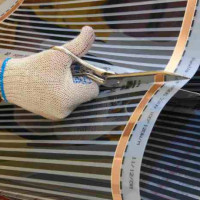 How to make a film underfloor heating under linoleum: instructions for laying an infrared heating system
How to make a film underfloor heating under linoleum: instructions for laying an infrared heating system 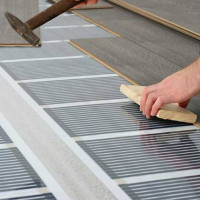 Warm floor under the laminate on the concrete floor: design nuances + detailed installation instruction
Warm floor under the laminate on the concrete floor: design nuances + detailed installation instruction 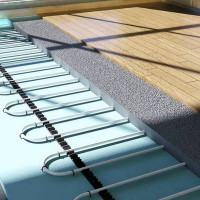 How to choose a warm floor under the laminate: a comparative analysis of the best options
How to choose a warm floor under the laminate: a comparative analysis of the best options 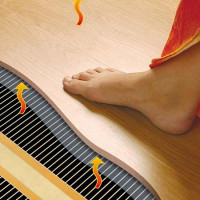 Underfloor heating under the laminate on the wooden floor: which system is better + installation instructions
Underfloor heating under the laminate on the wooden floor: which system is better + installation instructions 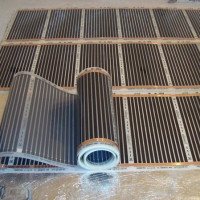 How to make an infrared warm floor with your own hands: installation and connection of a film floor
How to make an infrared warm floor with your own hands: installation and connection of a film floor 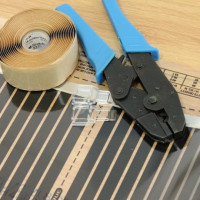 Linoleum electric underfloor heating: system advantages and installation instructions
Linoleum electric underfloor heating: system advantages and installation instructions  How much does it cost to connect gas to a private house: the price of organizing gas supply
How much does it cost to connect gas to a private house: the price of organizing gas supply  The best washing machines with dryer: model rating and customer tips
The best washing machines with dryer: model rating and customer tips  What is the color temperature of light and the nuances of choosing the temperature of the lamps to suit your needs
What is the color temperature of light and the nuances of choosing the temperature of the lamps to suit your needs  Replacement of a geyser in an apartment: replacement paperwork + basic norms and requirements
Replacement of a geyser in an apartment: replacement paperwork + basic norms and requirements
Quite an interesting method of floor insulation. I think such equipment and its installation are not worth the money. But you can try. My godfather has a similar system and heats the floor very well. And I wonder if this is safe. What if there is a short circuit? And if water leaks out? But godfather says that it is 100% safe. Perhaps it is, I'm not a pro. Nevertheless, I think that this is the future, and soon everyone will have such a heating system.
Personally, I did not choose a warm floor, as an alternative to heating. Yes, of course, this is a source of heat, but not the main one.And the coverage area should not occupy the entire floor surface. Regarding the question: is it expensive or cheap, I would say: "not cheap." And saving in this case is not appropriate, since capital work is being carried out. And do not save on this. Better to trust the professionals. The problem of crooked floors and poor-quality insulation has not been canceled.
It is expensive not only and not so much at the time of purchase and installation, but rather on the consumption of electricity for heating. If used as the main source of heating, it will turn out many times more expensive than gas. But as additional heating, the warm floor is very good.